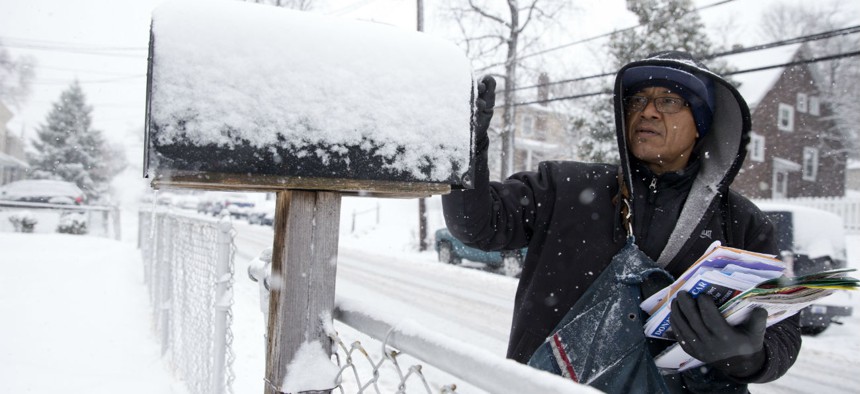Postal Service Sees More Cuts to Workforce Costs to Avoid Running Out of Money by 2024
In new strategic plan, postal management lays out a dire financial picture.
The U.S. Postal Service is on a course to run out of funds in five years and is calling on Congress to provide legislative reforms, including changes to employee compensation, to avoid that fiscal calamity.
USPS can regain its financial footing by 2024, the mailing agency said in a newly released five-year strategic plan, if it receives new flexibilities from lawmakers and its regulatory body. It plans to make changes internally as well, primarily by orienting more of its business toward e-commerce delivery and offering new digital services. The 245-year-old Postal Service promised to innovate more quickly and adapt to future platforms, rather than just its traditional physical delivery network.
Those changes alone, however, will not save the Postal Service, the agency said. It has lost nearly $78 billion since 2007, about three-quarters of which resulted from a statutory requirement to prefund health benefits for future retirees. USPS made clear its situation is dire.
“The most significant issue facing the Postal Service today is that our business model is unsustainable,” Postmaster General Megan Brennan and Chairman of the USPS Board of Governors Robert Duncan said in a joint letter accompanying the business plan. “This is due to increasingly conflicting mandates to be self-funding, compete for customers, and meet universal service obligations under highly regulated and legislated constraints.”
While the Postal Service hopes to grow revenue through package services—the agency said it would deliver all e-commerce shipments locally within 24 hours and anywhere in the contiguous United States within two business days—its market share has begun to decline as private sector companies and shippers have expanded their delivery networks. USPS said it will attract new customers by expanding services, such as growing the use of 24-hour self-service kiosks.
The Postal Service will also continue to squeeze costs out of its workforce, pledging to reach new collective bargaining agreements with employee unions that provide more favorable terms to the agency. It will enhance its pay-for-performance for non-union workers to better reward top employees. In the last decade, USPS has slashed 84,000 career positions in favor of creating lower compensated non-career posts. The agency has also established a new tier of lower-earning career workers. Still, postal management said retirement pensions and retiree health care make up 35% of its personnel costs, which continue to rise faster than inflation. The Postal Service said it must have legislative changes to those cost drivers or identify “other means of financing.” It previously detailed a 10-year business plan to Congress in which it floated dramatic changes to employees' pay and benefits.
USPS also promised to give employees better technology to carry out their jobs, such as equipping all workers with smart devices, and to improve oversight of worker safety.
To avoid defaulting on critical, day-to-day expenses, the Postal Service plans to provide a much larger offering of e-government services. The agency expects total mail volume to drop by 18% over the next five years while the number of addresses it must deliver to will increase, meaning USPS will lose more money for each delivery it makes. USPS projected a $4 billion loss in just the controllable part of its business in fiscal 2020, though it is currently working with the Postal Regulatory Commission in hopes of winning the right to increase its prices more quickly.
In their letter, Brennan and Duncan said lawmakers must answer a fundamental question to preserve the future of the nation’s mailing agency.
“What would you like the Postal Service to become and how would you like to pay for it?” they asked.
NEXT STORY: The Index: 2020 Edition




